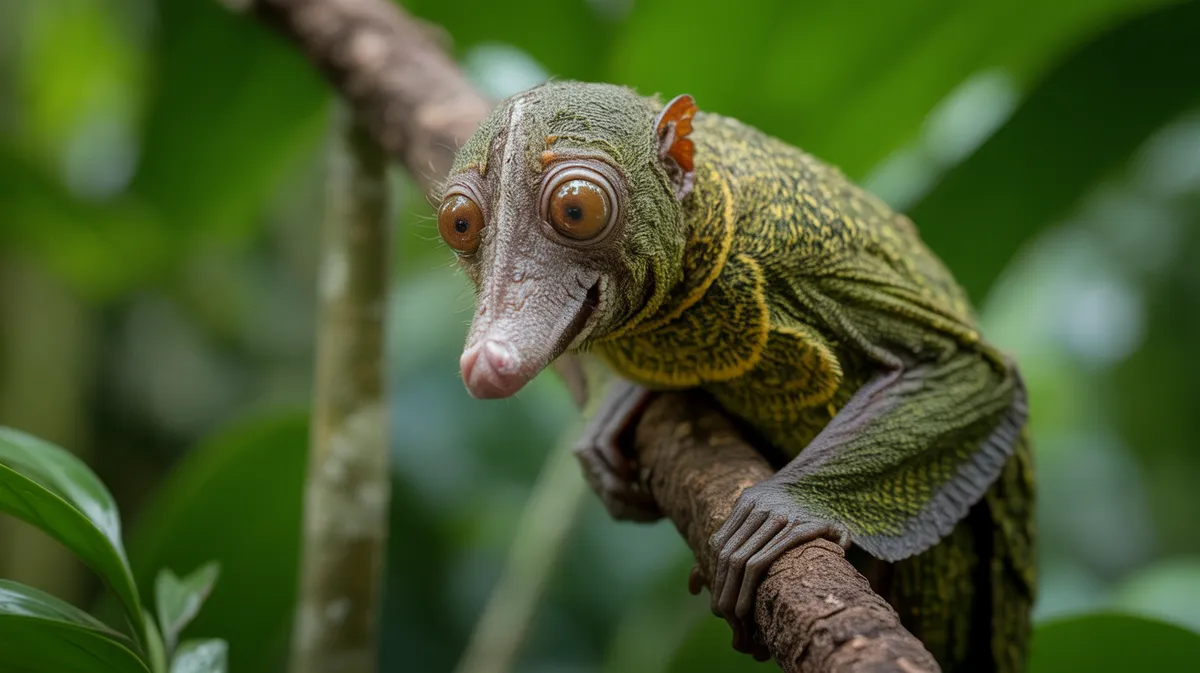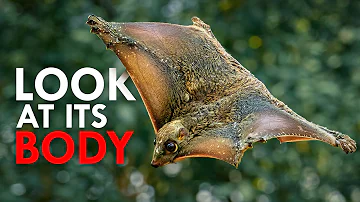
Colugo
Cynocephalus volans

Meet the Colugo
The colugo, also known as the Sunda flying lemur, is a gliding mammal native to Southeast Asia's forests. Despite its name, the colugo is neither a true lemur nor capable of powered flight, but it is renowned for its extraordinary gliding ability, enabled by a large membrane of skin stretching from its neck to the tips of its fingers, toes, and tail. Colugos are nocturnal and arboreal, spending nearly all their lives in trees where they feed primarily on leaves, shoots, flowers, and fruits. Their cryptic coloration and silent gliding make them difficult to spot in the wild, contributing to their elusive nature.
Classification
Mammal
Habitat
Tropical rainforest
Diet
Herbivore
Lifespan
10-15 years
Conservation
Least Concern
Weight
1-2 kg
📖Fascinating Facts
Exceptional Gliders
Colugos possess the largest gliding membrane proportionate to body size among all mammals, allowing them to glide long distances between trees.
Nocturnal Lifestyle
Colugos are active at night, using their strong claws to climb and their camouflage to avoid predators as they forage for food.
Unique Parental Care
Mother colugos carry their young clinging to their belly, protected by the patagium, which acts like a living pouch.
📋Detailed Description
The colugo (Cynocephalus volans), also known as the Philippine flying lemur, is a medium-sized arboreal mammal measuring 33–38 cm in head-body length, with a tail length of 17–27 cm and a weight ranging from 1 to 2 kg. Its most distinctive feature is the patagium, a broad gliding membrane that extends from the neck, along the limbs and digits, to the tip of the tail, providing the largest surface area relative to body size of any gliding mammal. This adaptation allows colugos to glide distances of over 100 meters between trees with minimal loss of altitude. The fur is dense, soft, and cryptically colored in mottled shades of gray, brown, or greenish, providing camouflage among tree bark and foliage. Colugos possess large, forward-facing eyes adapted for nocturnal vision, and a small, pointed head with a short snout. Their limbs are long and slender, with sharp, recurved claws for climbing vertical tree trunks. Colugos are strictly arboreal and rarely descend to the ground. They are solitary and highly territorial, with individuals occupying overlapping home ranges but rarely interacting directly. Their diet consists primarily of leaves, young shoots, flowers, and fruits, and their specialized dentition includes comb-like lower incisors used for grooming. Colugos exhibit a low metabolic rate and spend much of the day resting motionless on tree trunks, becoming active at dusk to forage. Their reproductive strategy involves a single offspring per litter, which clings to the mother’s belly and is sheltered by the patagium, resembling a marsupial pouch.
💡 Did you know?
Colugos are the closest living relatives to primates, despite their unusual appearance and gliding lifestyle.
🔬Research & Sources
Wikipedia Summary
Colugos, flying lemurs, or cobegos, are arboreal gliding euarchontogliran mammals that are native to Southeast Asia. Their closest evolutionary relatives are primates. There are just two living species of colugos: the Sunda flying lemur and the Philippine flying lemur. These two species make up the entire family Cynocephalidae and order Dermoptera, from Ancient Greek δέρμα (dérma) "skin" and πτερόν (pterón) "wing".
Last Modified: 5/26/2025
🎭Behavior & Social Structure
Colugos are strictly nocturnal, emerging at dusk to forage for food in the forest canopy. They are highly agile climbers, using their sharp claws to ascend vertical surfaces and move between branches. Gliding is their primary mode of locomotion between trees, and they can steer and control their descent with remarkable precision, using their tail and limbs to adjust the tension and shape of the patagium. Colugos are solitary, with each individual maintaining a home range that may overlap with others, but direct social interactions are rare outside of the mother-offspring bond. They communicate primarily through scent marking and occasional vocalizations, such as soft clicks or squeaks. During the day, colugos rest flattened against tree trunks, relying on their cryptic coloration to avoid detection by predators. Feeding behavior is slow and deliberate; they use their incisors to scrape leaves and flowers, and their long tongue to extract nectar or soft plant material.
👶Reproduction & Life Cycle
Colugos are believed to breed year-round, with no strict breeding season, although some local populations may show seasonal peaks. After a gestation period of approximately 60 days, the female gives birth to a single, highly altricial young. The neonate is underdeveloped and clings to the mother’s abdomen, where it is protected and supported by the patagium, which the mother curls around the infant. The young remain attached to the mother for 5–6 months, during which time they are nursed and gradually introduced to solid food. Weaning occurs at about 6 months, but juveniles may remain with the mother for several additional months before becoming fully independent. Parental care is provided exclusively by the female; males do not participate in rearing the young.
🛡️Adaptations & Survival
Colugos exhibit several remarkable adaptations for arboreal gliding. The patagium is unique among mammals, extending not only between the limbs but also between the digits and the tail, maximizing lift and maneuverability. Their lightweight skeleton and elongated limb bones facilitate efficient gliding. The large, forward-facing eyes provide excellent night vision, essential for nocturnal navigation. Specialized comb-like lower incisors (pectinate teeth) are used both for grooming and for processing fibrous plant material. Their low metabolic rate reduces energy requirements, allowing them to subsist on a diet of low-calorie leaves. The cryptic coloration of their fur provides camouflage from predators such as large birds of prey, snakes, and arboreal carnivores. Behavioral adaptations include strict nocturnality and a tendency to remain motionless during the day to avoid detection.
📚Research Sources
🎨Cultural Significance
Colugos have a modest presence in local folklore and traditional beliefs in parts of Southeast Asia. In the Philippines, they are sometimes associated with omens or spirits of the forest, and their gliding ability has inspired myths about flying creatures. In some indigenous cultures, colugo fur or body parts have been used in traditional medicine, though this practice is rare. Their unique appearance and behavior have made them subjects of interest in ecotourism and wildlife education, but they are not widely featured in art or symbolism compared to other regional fauna.
🔬Recent Research & Discoveries
Recent genetic studies have clarified the evolutionary relationships of colugos, confirming that their closest living relatives are primates, with divergence estimated at over 80 million years ago. Ongoing research focuses on the biomechanics of their gliding, revealing that colugos can achieve glide ratios of up to 2.5:1 (horizontal distance to vertical drop), rivaling or exceeding those of flying squirrels. Studies on their diet using stable isotope analysis have shown a preference for young, nutrient-rich leaves and flowers, with occasional consumption of fruit and sap. Conservation research is increasingly using camera traps and radio telemetry to monitor colugo populations and habitat use. There is also growing interest in the microbiome of colugos, given their specialized folivorous diet, and in the potential impacts of climate change on their forest habitats.
🎥Wildlife Videos

Is This Weird Animal Our Closest Relative?
Colugos are sometimes called flying lemurs – even though they don't fly and are not lemurs. But what they really are, is a 200 year ...
Bizarre Beasts

The Colugo Is The Strangest Animal You’ve Never Heard Of
Colugos look like they're straight out of the primate uncanny valley. Become an Animalogic member: ...
Animalogic

The Colugo
This is a video of the colugo taken from the BBC's Planet Earth documentary series.
globalzoo

Colugo: The WEIRDEST Gliding Animal
I travel to the Philippines to film the colugo or flying lemur, the weirdest gliding creature on earth. I explore the Raja Sikatuna, the ...
The Wild Files

Sunda Colugo - 5 Minute Documentary
Journey into the lush rainforests of Southeast Asia with an enchanting five-minute documentary on the Sunda Colugo, ...
Five Minute Documentaries

Malayan Colugo | Wildlife Documentary | Informative #wildanimals#wildbird#seaanimal#animals#wildlife
Malayan Colugo | Wildlife Documentary | Informative #wildanimals#wildbird#seaanimal#animals#wildlife ...
Animals World.official
🌍Habitat Information
The Colugo typically inhabits Tropical rainforest environments. Colugos have adapted to their environments with specialized features and behaviors.
Primary Habitat:
Tropical rainforest
More detailed habitat information will be available soon.
🛡️Conservation Status
The Colugo is currently classified as Least Concern. Conservation efforts are crucial for preserving this species for future generations.
Common Threats:
- 🏠Habitat loss and fragmentation
- 🌡️Climate change impacts
- 🎯Hunting and poaching
- 🏭Human-wildlife conflict
⚠️Threats & Conservation Challenges
Although currently listed as Least Concern by the IUCN, colugos face several threats, primarily habitat loss due to deforestation, logging, and agricultural expansion in Southeast Asia. Fragmentation of forest habitats can isolate populations and reduce genetic diversity. Colugos are sometimes hunted for their meat or for traditional medicine, although this is not widespread. They are also vulnerable to predation by raptors, civets, and large snakes. Despite their elusive nature, colugos are sensitive to environmental changes and may serve as indicators of forest health. Conservation challenges include the need for large, contiguous tracts of forest to support viable populations and the lack of detailed population data due to their cryptic behavior.
🔬Scientific Classification
Scientific Name
Cynocephalus volans
Classification Hierarchy
🔍 About Taxonomic Classification
Taxonomic classification is a hierarchical system used by scientists to classify and organize living organisms based on shared characteristics and evolutionary relationships.
The system moves from broad categories (Kingdom) to increasingly specific ones, with each animal's scientific name typically consisting of its Genus and species.
📝Community Notes
Share your observations and insights about the Colugo with our community of wildlife enthusiasts.
Join Our Community
Sign in to share your observations and connect with fellow wildlife enthusiasts.
Sign In to ContributeNo community notes yet
Be the first to share your observations about the Colugo!
Explore Colugo
Select a tab above to learn more about this amazing animal.
📸Photo Gallery
No photos available for this animal yet.
🌟Discover More Wildlife
Continue your journey of discovery with more fascinating animals from our database
